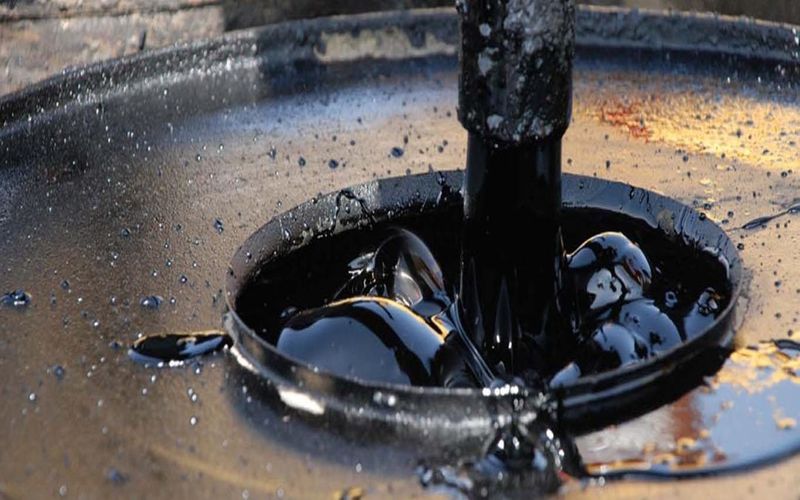🛢️ What is Bitumen and How Is It Produced?
Bitumen is a black, sticky, and highly viscous liquid or semi-solid form of petroleum. It softens when heated and hardens upon cooling, making it an ideal material for paving roads and waterproofing buildings.
In addition, bitumen’s thermoplastic nature allows it to be reshaped and reused without losing its essential properties.
🔬 Bitumen Production Process
The production of bitumen begins after crude oil is extracted and transported to a refinery. Here’s a step-by-step overview:
-
Pre-heating: The crude oil is first heated to about 200°C to reduce its viscosity.
-
Furnace Heating: Next, it enters a high-temperature furnace, reaching approximately 300°C.
-
Fractional Distillation: Then, the oil is directed into a distillation column. Lighter compounds rise to the top, while heavier materials like bitumen sink to the bottom.
-
Vacuum Distillation: Finally, the remaining residue is distilled again under reduced pressure. This yields Straight Run Bitumen—the most basic and widely used type.
As a result, the bitumen grade depends on how much volatile material remains in the final product. More volatiles create a softer and more fluid grade, while less volatiles result in harder, more durable material.
🛣️ Applications of Bitumen
Penetration-grade bitumen is the most common type used in road surfacing.
-
In warm climates, lower penetration grades (harder bitumen) are preferred.
-
In colder regions, higher penetration grades (softer bitumen) perform better, as they resist cracking in low temperatures.
Moreover, bitumen is also used in roofing, waterproof membranes, and industrial sealants.
Penetration Bitumen Grade
| Characteristics | Test Method | 30-40 | 40-50 | 60-70 | 85-100 | 100-120 |
|---|---|---|---|---|---|---|
| Specific Gravity @25/25°C | ASTM D-70 | 1.01-1.06 | 1.01-1.06 | 1.01-1.06 | 1.01-1.05 | 1.01-1.04 |
| Penetration @ 25°C | ASTM D-5 | 30-40 | 40-50 | 60-70 | 85-100 | 100-120 |
| Softening Point °C | ASTM D-36 | 55-63 | 52-60 | 49-56 | 45-52 | 42-49 |
| Ductility at 25 °C | ASTM D-113 | 100min | 100min | 100min | 100min | 100min |
| Weight Loss by Heating %wt | ASTM D-6 | 0.2 Max | 0.2 Max | 0.2 Max | 0.2 Max | 0.2 Max |
| Drop In Pen After Heating % | ASTM D-6 & D-5 | 20 Max | 20 Max | 20 Max | 20 Max | 20 Max |
| Flash Point °C | ASTM D-92 | 250min | 250min | 250min | 250min | 250min |
| Solubility In Tce | ASTM D-4 | 99.5min | 99.5min | 99.5min | 99.5min | 99.5min |
| Stain Test | A.A.S.H.T.O.T.102 | Negative | Negative | Negative | Negative | Negative |
| Tolerance: ± 5% | Packing Type |
Net Weight |
Tare Weight |
Gross Weight |
No. of Packing in Cntr. 20′ |
Net Weight per Cntr. 20′ |
Gross Weight per Cntr. 20′ |
|---|---|---|---|---|---|---|---|
| Drums | 150 KG | 8.3 KG | 158.3 KG | 110 | 16.500 MT | 17.400 MT | |
| Drums | 185 KG | 9.3 KG | 194.3 KG | 110 | 20.350 MT | 21.370 MT |
Viscosity Grade
| Characteristics | VG-10 | VG-20 | VG-30 | VG-40 |
|---|---|---|---|---|
| Absolute viscosity 60 c , poises , min | ASTM D-70 | 1.01-1.06 | 1.01-1.06 | 1.01-1.06 |
| Kinematic Viscosity , 135oc , CST , min | ASTM D-5 | 30-40 | 40-50 | 60-70 |
| Flash point , C , min | ASTM D-36 | 55-63 | 52-60 | 49-56 |
| solubility in trichloroethylene , % , min | ASTM D-113 | 100min | 100min | 100min |
| penetration at 25 c | ASTM D-6 | 0.2 Max | 0.2 Max | 0.2 Max |
| softening point , C , min | ASTM D-6 & D-5 | 20 Max | 20 Max | 20 Max |
| Tests on residue from thin film over test / RTFOT: | ||||
|---|---|---|---|---|
| i.Viscosity ratio at 60oc , max | 4 | 4 | 4 | 4 |
| ii. Ductiliy at 25oc , CM , min75444 | 75 | 50 | 40 | 25 |
| Tolerance: ± 5% | Packing Type |
Net Weight |
Tare Weight |
Gross Weight |
No. of Packing in Cntr. 20′ |
Net Weight per Cntr. 20′ |
Gross Weight per Cntr. 20′ |
|---|---|---|---|---|---|---|---|
| Drums | 150 KG | 8.3 KG | 158.3 KG | 110 | 16.500 MT | 17.400 MT | |
| Drums | 185 KG | 9.3 KG | 194.3 KG | 110 | 20.350 MT | 21.370 MT |



